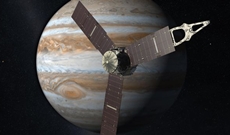Nasa’s Juno spacecraft to start orbiting Jupitor on 5 July
05 Jul 2016
NASA's Juno spacecraft will enter a pole to pole orbit of Jupitor at 8 am (IST) on 5 July, after a five-year solar powered spaceflight from Earth, to study the solar system's largest planet.
 If everything goes as planned, Nasa will start streaming the orbital manoeuvre on Facebook Live.
If everything goes as planned, Nasa will start streaming the orbital manoeuvre on Facebook Live.
From a unique polar orbit, Juno will repeatedly dive between the planet and its intense belts of charged particle radiation, coming only about 3,000 miles (5,000 kilometers) from the cloud tops at closest approach.
Juno's primary goal is to improve our understanding of Jupiter's formation and evolution. The spacecraft will investigate the planet's origins, interior structure, deep atmosphere and magnetosphere. Juno's study of Jupiter will help us to understand the history of our own solar system and provide new insight into how planetary systems form and develop in our galaxy and beyond, says a Nasa release.
The mission will allow Nasa to revisit Jupiter probe after almost 10 years. The previous mission was the Galileo orbiter, and a probe that was dropped into the atmosphere.
The orbital insertion manoeuvre involves slowing the spacecraft down using a 35 minute burn on Juno's main engines. This will put Juno in a pole-to-pole orbit on Jupiter, something that has never been done before.
The closer orbit fly-by will allow the spacecraft to gaze deep into the planet with its various sensors, and unlock its secrets.
The mission was named Juno after the Roman goddess who could see through clouds.
The spacecraft will orbit Jupiter 37 times during a period of 20 months, before falling into the planet. Juno's primary objective is to explore the process of the creation of the planet Jupiter. By extension, this will allow scientists to have increased understanding of planet formation in general, and about the formation of the solar system, as well as planetary systems around other stars.
The spacecraft will measure the amount of water content in the atmosphere of Jupiter, settling disputes on which theory of planet formation is the correct one, and if new ones are required to explain the acquired data.
The probe will study characteristics of Jupiter's volatile atmosphere, observing composition, temperature and the movements of clouds as also magnetic and gravitational fields, allowing scientists to make better guesses at the internal structure of the gas giant.
Most interestingly, the pole to pole orbit will allow Juno to study the spectacular aurourae on both the north and south poles of Jupiter.
Juno carries a number of scientific instruments and sensors, including three static aluminum minifigs that will help the spacecraft gather scientific data. The specially made LEGO minifigs will serve as inspiration to children, and get them interested in the space programme.
The three minifigs are of the Roman God Jupiter, his wife Juno who the mission is named after, and Galileo, the Italian astronomer.






























